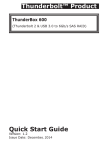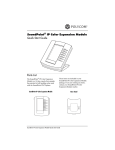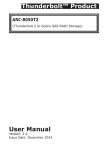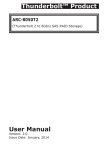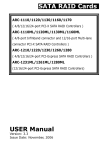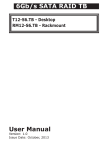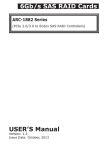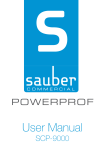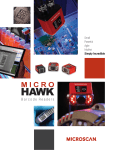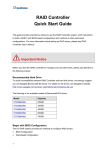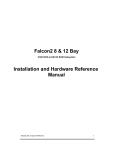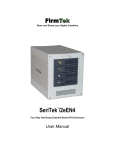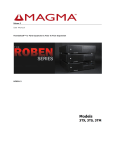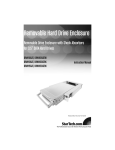Download installation
Transcript
Thunderbolt™ Product ARC-8050T2 (Thunderbolt 2 to 6Gb/s SAS RAID Storage) Quick Start Guide Version: 2.0 Issue Date: January, 2014 Copyright and Trademarks The information regarding products in this manual is subject to change without prior notice and does not represent a commitment on the part of the vendor, who assumes no liability or responsibility for any errors that may appear in this manual. All brands and trademarks are the properties of their respective owners. This manual contains materials protected under International Copyright Conventions. All rights reserved. No part of this manual may be reproduced in any form or by any means, electronic or mechanical, including photocopying, without the written permission of the manufacturer and the author. FCC Statement This equipment has been tested and found to comply with the limits for a Class B digital device, pursuant to part 15 of the FCC Rules. These limits are designed to provide reasonable protection against interference in a residential installation. This equipment generates, uses, and can radiate radio frequency energy and, if not installed and used in accordance with the instructions, may cause harmful interference to radio communications. However, there is no guarantee that interference will not occur in a particular installation. Manufacturer’s Declaration for CE Certification We confirm ARC-8050T2 has been tested and found compliant with the requirements in the council directive relating to the EMC Directive 2004/108/EC. Regarding to the electromagnetic compatibility, the following standards were applied: EN 55022: 2006, Class B EN 61000-3-2: 2006 EN 61000-3-3: 1995+A1: 2001+A2: 2005 EN 55024:1998+A1:2001=A2:2003 IEC61000-4-2: 2001 IEC61000-4-3: 2006 IEC61000-4-4: 2004 IEC61000-4-5: 2005 IEC61000-4-6: 2006 IEC61000-4-8: 2001 IEC61000-4-11: 2004 Contents 1. Installation................................................................... 4 1.1 Before You First Installing...................................................4 1.2 Summary of RAID Storage Setup Steps.................................5 • For Mac OS X....................................................................5 • For Windows.....................................................................5 1.3 RAID Storage View.............................................................7 1.4 Locations of the Storage Component.....................................8 1.4.1 Drive Tray LED Indicators...............................................8 1.4.2 LCD Panel LED Indicators...............................................9 1.4.3 Thunderbolt Port LED Indicators......................................9 1.5 Setting Up RAID Storage................................................... 10 1.5.1 Physically Install RAID Storage and Drives...................... 10 1.5.2 Mac Users.................................................................. 14 1.5.2.1 Install the MRAID Software...................................... 14 1.5.2.2 Configure RAID Volumes.......................................... 18 1.5.2.3 Format RAID Volumes............................................. 21 1.5.2.4 Make A Bootable RAID Volume................................. 23 1.5.2.5 Unmounting RAID Volumes...................................... 23 1.5.3 Windows Users........................................................... 24 1.5.3.1 Install the MRAID Software...................................... 24 1.5.3.2 Configure RAID Volumes.......................................... 28 1.5.3.3 Format RAID Volumes............................................. 31 1.5.3.4 Unmounting RAID Volumes...................................... 31 2. Specification............................................................... 33 2.1 Overview........................................................................ 33 2.2 Features......................................................................... 35 INSTALLATION 1. Installation This section describes how to install the ARC-8050T2 Thunderbolt 2 RAID storage with host computer and disks. 1.1 Before You First Installing Thanks for purchasing the ARC-8050T2 as your RAID data storage. The following manual gives simple step-by-step instructions for installing and configuring the ARC-8050T2 RAID storage. Unpack Unpack and install the hardware in a static-free environment. ARC-8050T2 RAID storage is packed inside an anti-static bag between two sponge sheets. Remove it and inspect it for damage. If the ARC-8050T2 RAID storage appears damaged, or if any items of the contents listed below are missing or damaged, please contact your dealer or distributor immediately. Checklist • 1 x ARC-8050T2 8-bays RAID storage unit • 1 x Installation CD – containing driver, relative software, an electronic version of this manual and other related manual • 1 x RJ-45 LAN cable • 1 x Thunderbolt cable • 1 x Power cord • 32 x Drive mounting screws (4 per drive tray) • 1 x Quick start guide System Requirements • Computer with Thunderbolt connector • Mac OS X 10.8.5 or higher • Windows 7&8 “For Windows PC: the Thunderbolt certified device driver must be installed before plugging in the device for it to function properly” 4 INSTALLATION 1.2 Summary of RAID Storage Setup Steps • For Mac OS X Step 1. Physically Install the Hardware (Chapter 1.5.1) 1. Install HDDs. 2. Connect power cord. 3. Connect Thunderbolt cable. Step 2. Install the MRAID Software Package (Chapter 1.5.2.1) 1. Download the install_mraid installer from the website at “http://www.areca.com.tw/support/s_ thunderbolt/thunder bolt.htm”. 2. Double-click on the install_mraid zipped file. 3. Double-click on the install_mraid icon on the Finder. 4. Follow the installer on-screen steps to complete the installation. Step 3. Configure RAID Volumes (Chapter 1.5.2.2) 1. Double-click on the “MRAID” icon on the desktop. 2. Double-click on the “ArcHTTP64”. 3. Locate “ARC-8050T2 Web Management” and launch the McRAID storage manager. 4. Login User Name “admin” and the Password “0000”. 5. Click on the “Quick Create” to configure the volume. 6. Follow the on-screen steps to complete the configuration. Step 4. Format RAID Volumes (Chapter 1.5.2.3) 1. Mac OS X recognizes that a new disk is available. 2. Follow the Disk Utility on-screen steps to initialize and partition your unit. 3. Icons for each new partition show up on your desktop. 4. They are now ready to use. • For Windows Step 1. Physically Install the Hardware (Chapter 1.5.1) 1. Install HDDs. 2. Connect power cord. 3. Connect Thunderbolt cable. 5 INSTALLATION Step 2. Install the MRAID Software Package (Chapter 1.5.3.1) 1. Download the install_mraid installer from the website at “http://www.areca.com.tw/support/s_ thunderbolt/thunder bolt.htm”. 2. Double-click on the install_mraid zipped file. 3. Double-click on the “setup.exe” unzip file. 4. Follow the installer on-screen steps to complete the installation. Step 3. Configure RAID Volumes (Chapter 1.5.3.2) 1. Double-click on the “MRAID” icon on the desktop. 2. Double-click on the “ArcHTTP64”. 3. Locate “ARC-8050 Web Management” and launch the McRAID storage manager. 4. Login User Name “admin” and the Password “0000”. 5. Click on the “Quick Create” to configure the volume. 6. Follow the on-screen steps to complete the configuration. Step 4. Format RAID Volumes (Chapter 1.5.3.3) 1. Click “Start” ==> right-click “Computer” and select “Manage”. 2. Click “Disk Management” in the left pane. 3. Scroll down to the bottom of the middle pane. Windows will display a list of new drives attached to your system with a label such as “Disk 1” or “Disk 2”, etc. 4. Right-click on the drive you want to partition and then again to format it. 5. Once it’s formatted, Windows automatically assigns the next available drive letter to it and then it will appear in Windows Explorer. 6. They are now ready to use. 6 INSTALLATION 1.3 RAID Storage View The following diagram is the RAID storage front view and rear view. Front View 1. Disk Activity LED 2. Disk Fault / Link LED 3. LCD Panel with Keypad Rear View 4. 5. 6. 7. 8. 9. Thunderbolt Port1 Thunderbolt Port2 Thunderbolt Port1 Link LED Thunderbolt Port2 Link LED System Fan1 LAN Port (For McRAID Web Manager) 10. Reset Button 11. System Fan2 12. Power Connector 13. Power Supply Fan 7 INSTALLATION 1.4 Locations of the Storage Component The following components come with LEDs that inform ARC-8050T2 RAID storage managers about the operational status. 1.4.1 Drive Tray LED Indicators Figure 1-1, Activity/Fault LED The following table describes the RAID storage disk drive tray LED behavior. Tray LED 8 Normal Status Problem Indication 1. Activity LED (Blue) 1. When the activity LED is lit, there is I/O activity on that disk drive. 2. When the LED is not lit; there is no activity on that disk drive. N/A 2. Fault/Link LED (Red/Green) 1. When the fault LED is lit, there is no disk present. 2. When the link LED is lit, there is a disk present. 1. When the fault LED is off, the disk is present and status is normal. 2. When the fault LED is blinking (2 times/sec.), the disk drive has failed and should be hotswapped immediately. 3. When the activity LED is lit and fault LED is fast blinking (10 times/sec.) there is rebuilding activity on that disk drive. INSTALLATION 1.4.2 LCD Panel LED Indicators There are a variety of status conditions that cause the RAID storage panel monitoring LED to light. The front panel LCD comes with three (3) status-indicating LEDs. The LEDs on the front panel are defined, from top to bottom, Power, Busy, and Caution, as shown in Figure 1-2. Figure 1-2, LCD Panel LED The following table provides a summary of the front panel LED. Panel LED Normal Status Problem Indication 1. Power LED (Green) Solid green, when power on. Unlit, when power on. 2. Busy LED (Amber) Blinking amber during host accesses RAID storage. Unlit or never flicker. 3. Caution LED (Red) Unlit indicates that the RAID storage and all its components are operating correctly. Solid indicates that one or more component failure/Urgent events have occurred. 1.4.3 Thunderbolt Port LED Indicators Figure 1-3, Thunderbolt Ports LED The following table describes the ARC-8050T2 SAS RAID storage Thunderbolt port link LED behavior. 9 INSTALLATION Thunderbolt Ports Link LED Status Green light 1. Lit indicates RAID storage is powered and maintained the daisy chain with other Thunderbolt devices. 2. Blinking (5 times/sec) that indicates RAID storage is in sleep mode. 3. Blinking (1 time/sec) that indicates RAID storage is powered down and maintained the daisy chain with other Thunderbolt devices. Amber light There is a proper DisplayPort connection on that Thunderbolt port. Red light There is a proper DisplayPort to DVI connection on that Thunderbolt port. 1.5 Setting Up RAID Storage Setting up your ARC-8050T2 RAID storage involves these main steps: • Physically Install the RAID Storage and Drives • Install the MRAID Software • Configure RAID Volumes • Format RAID Volumes • Unmounting RAID Volumes Details about these steps are described in the following sections. 1.5.1 Physically Install RAID Storage and Drives Please follow the steps below in order they are given to ensure that your ARC-8050T2 connected on your Thunderbolt computer. Step 1. Install the Drives in the ARC-8050T2 RAID Storage Your RAID storage supports up to 8 x 3.5-inch disk drives or 8 x 2.5-inch SAS or SATA 6.0Gb/s drives, each one contained in its individual hole on the disk carrier. Each drive is hot-pluggable, allowing you to remove and insert drives without shutting down your RAID storage. Installation in this section describes how to install or remove 3.5 inch drives in your RAID storage. 1. Gently slide the drive tray out from the ARC-8050T2 RAID storage. 10 INSTALLATION 2. Install the drive into the drive tray and secure the drive to the drive tray by four of the mounting screws. Figure 1-4-1. Installing 2.5-inch SAS/SATA Drive Figure 1-4-2. Installing 3.5-inch SAS/SATA Drive 3. After all drives are in the drive tray, slide all of them back into the ARC-8050T2 RAID storage and make sure you latch the drive trays. Figure 1-5, Sliding Drive Tray into Enclosure Step 2. Connecting RAID Storage to Thunderbolt Ports Thunderbolt connectors are provided on the back of the ARC8050T2 RAID storage for connecting the array to Thunderbolt host and next Thunderbolt devices. There are two Thunderbolt connectors on the rear of ARC-8050T2 RAID storage. You can plug-in two host ports. 1. Direct connection to a Thunderbolt technology capable computer. 2. Daisy chaining Thunderbolt capable devices and displays. 11 INSTALLATION • Thunderbolt Computer Port Connection By installing Thunderbolt technology capable computer and ARC-8050T2 Thunderbolt port using the Thunderbolt cable which is included in your Thunderbolt capable computer. Then connect ARC-8050T2 RAID storage and Thunderbolt technology capable computer port as shown below: Figure 1-6, Connecting to Thunderbolt Computer • Daisy Chain Topologies A single Thunderbolt technology daisy chain can have seven devices, including the computer. Connect the cable to one of the interface ports on the back of your ARC-8050T2 RAID storage and to your Thunderbolt capable computer. The additional port may be used to daisy chain compatible computer peripherals, such as hard drives, monitors, and much more. A single Thunderbolt port supports hubs as well as a daisy chain of up to seven Thunderbolt devices on, including the Thunderbolt capable computer. 12 INSTALLATION Figure 1-7, Thunderbolt Computer Daisy Chain Step 3. Connecting Monitor Port (Optional) You can connect LAN port to the manager clinet system, if you want to configure and manage the RAID storage from the clinet system through out-of-band manager. • LAN Port Connection User can remote manage the RAID enclosure without adding any user specific software (platform independent) via standard web browsers directly connected to the 10/100Mbit RJ45 LAN port. Connect LAN port of the ARC-8050T2 using the included Ethernet cable and then to a LAN port or LAN switch. Step 4. Connecting RAID Storage Power To power the RAID storage: 1. Using the included power cord, connect this power cord to a grounded electronical outlet and to the ARC-8050T2 RAID storage. 2. ARC-8050T2 RAID storage will automatically turn on when host computer power on status is received from the thunderbolt cable. It takes about 30 seconds to fully start up the RAID storage. 13 INSTALLATION Figure 1-8, Connecting the Power to Enclosure. 3. ARC-8050T2 RAID storage automatically turns off when the computer to which it is attached sleeps or is disconnected. Note: You can press and hold the “Reset” button for 3 seconds to force the RAID storage AC power on or off. When you are finished installing the ARC-8050T2 RAID storage, you can set up the RAID volume using McRAID storage manager or LCD to set up RAID volumes. 1.5.2 Mac Users 1.5.2.1 Install the MRAID Software This section describes detailed instructions for installing the Areca Mac driver & utility for the ARC-8050T2 on your Apple Thunderbolt capable machine. You must have administrative level permissions to install Mac OS X driver & utility. This can be done in just a few steps! 1. Download the install_mraid installer from the website at "http://www.areca.com.tw/support/s_ thunderbolt/thunderbolt.htm", the file name begins with “install_mraid” followed by the version control or insert the ARC-8050T2 software CD in the CD-ROM drive. 14 INSTALLATION 2. Double-click on the zipped file that comes from the website or resides at <CDROM>\packages\MacOS to add the installer on the Finder. 3. Launch the installer by double-clicking the install_mraid on the Finder. The MRAID Installer opens. Click on the "Next" button to begin the installation. 4. The MRAID Installer opens. Click on the "Next" button to begin the installation. 5. On the Choose Install Set screen, click on an icon to install special components and click on the "Next" button to continue. • Driver is required for the operating system to be able to interact with the ARC-8050T2 RAID storage. 15 INSTALLATION • ArcHTTP has to be installed for GUI RAID console (MRAID storage manager) to run. It also runs as a service or daemon in the background that allows capturing of events for mail and SNMP traps notification. Refer to the Chapter 5 ArcHTTP Configuration on ARC-8050T2 user manual, for details about the mail and SNMP traps configuration. • CLI (Command Line Interface) provides the functionality available in MRAID storage manager through a Command Line Interface. You can set up and manage RAID storage inline. CLI performs many tasks at the command line. You can download CLI manual from Areca website or software CD <CDROM>\ DOCS directory. 6. On the Choose Alias Folder screen, click on an icon to choose where you like to create aliases and click on the "Next" button to continue. 7. On the Pre-Installation Summary screen, review your installation setting and click on the "Install" button to continue. If you want to change any of your installation setting, click on the "Previous" button. 16 INSTALLATION 8. A program bar appears that measures the progress of the driver installation. 9. When this screen shows, you have completed the driver installation and click on the "Next" button to continue. 17 INSTALLATION 10. After installation is completed, click on the "Done" button to reboot your computer in order to complete installation. 11. The ArcHTTP and ArcCLI are installed at the same time on ARC-8050T2. Once ArcHTTP and CLI have been installed, the ArcHTTP background task automatically starts each time when you start your computer. There is one MRAID icon showing on your desktop. This icon is for you to launch the McRAID storage manager (by ArcHTTP) and CLI utility. If you have not yet installed the hardware, please follow the “1.5.1 Physically Install RAID Storage and Drives” section to install it. Otherwise, to begin the creation volume, go on the “1.5.2.2 Configure RAID Volumes” section to configure the volume. 1.5.2.2 Configure RAID Volumes There are often multiple ways to accomplish the same configuration and maintenance tasks for your RAID storage. Your ARC8050T2 RAID storage can be configured by one of the following methods: 1. McRAID Storage Manager from ArcHTTP. (Thunderbolt port) 2. McRAID Storage Manager Through LAN port. 3. LCD Panel with Keypad. 18 INSTALLATION • Method 1: McRAID Storage Manager From ArcHTTP Start McRAID Storage Manager – Browser Edition There is one “MRAID” icon showing on your desktop. Doubleclick on the “MRAID” icon to locate your ArcHTTP utility and CLI program file folder. When you double-click on the “ArcHTTP64”, it shows all RAID storages available on the system and create an individual RAID storage icon located on left column of the “ArcHTTP Configurations” screen. Locate “ARC-8050T2 Web Management” and launch the selected McRAID storage manager. Enter RAID storage default User Name “admin” and the Password “0000” when the login page prompted for it. After logging in, the McRAID storage manager process starts. 19 INSTALLATION Click on the “Quick Create” in the main menu, your volume is automatically configured based on the number of disks in your system. You can create a RAID set associated with exactly one volume set. The user can change the Raid Level, Capacity, Initialization Mode, and Stripe Size. A hot spare option is also created, depending on the exist configuration. Click on the “Confirm The Operation” check box and click on the “Submit” button, the RAID set and volume set will start to initialize. If you prefer to customize your volume set, please use the “Raid Set Functions” and “Volume Set Functions”. See chapter 4 of ARC-8050T2 user manual for information on customizing your RAID volumes using McRAID storage manager. Otherwise, to begin using the ARC-8050T2 right away, go on the next “Format the Volume” section to begin the formatting procedure. • Method 2: McRAID Storage Manager Through LAN port User can remote manage the RAID storage directly connected to the 10/100Mbits RJ45 LAN port via standard web browsers.To configure ARC-8050T2 RAID storage using a LAN port, you need to know its IP address. The default IP address will be shown on the LCD initial screen. Launch your web browserbased McRAID storage manager by entering http://[IP Address] in the web browser. Enter RAID storage default User Name “admin” and the Password “0000” when the login page prompted for it. After logging in, the McRAID storage manager process starts. Follow the on-screen steps, responding as needed, to configure RAID volume. See the Chapter 4 of ARC-8050T2 user manual for information on customizing your RAID volumes using McRAID storage manager. 20 INSTALLATION • Method 3: LCD Panel with Keypad You can use LCD front panel and keypad function to simply create the RAID volume. The LCD status panel also informs you of the disk array’s current operating status at a glance. The LCD configuration is described in a separate manual: ARC8050T2_LCD manual. It is available on your Areca CD, in the / docs folder. The LCD provides a system of screens with areas for information, status indication, or menus. The LCD screen displays up to two lines at a time of menu items or other information. ARC-8050T2 RAID storage default User Name is “admin” and the Password is “0000”. The LCD initial screen is shown below: 1.5.2.3 Format RAID Volumes After the volume set is ready for system accesses, it needs to be partitioned, formatted, and mounted by the operating system. When you create a volume through McRAID storage manager, the Mac OS X recognizes that a new disk is avail, and displays a message asking what you next want to do. If the message does not show up, start the “Disk Utility” manually from the “Finder”, use the “Go” menu and open the “Utilities” folder. Double-click on the “Disk Utility” program. To initialize and partition your unit 1. When the Disk Utility window opens, find and select the desired drive in the sidebar that represents your RAID storage and click on the “Partition” button. 21 INSTALLATION 2. In the Partition Layout column, click on the “Current” to show the drop-down menu and select the number of partitions that you want your RAID storage to have. Each partition will appear as a separate drive on your computer. 3. Specify your Partition Information, Option setting and click on the “Apply” button. If you’re not sure which format to use, choose Mac OS X Extended (Journaled). 4. When a message asks you to confirm you want to partition the disk, click on the “Partition” button. This may take a couple of minutes, depending on the size of the drives in your RAID storage. When the partitioning is complete, icons for each new partition show up on your desktop. They are now ready to use. 22 INSTALLATION 1.5.2.4 Make A Bootable RAID Volume You can follow the following procedures to add ARC-8050T2 RAID volume on Intel-based Mac bootable device listing. 1. Set the BIOS selection in System Controls: Advance Configuration to “EFI” option for Intel-based Mac boot. 2. Download OS X Mavericks and DiskMaker X. Follow the DiskMaker X to make a bootable OS X Mavericks USB install drive. 3. Restart your Mac and after you hear the chime sound, press the Option (Alt) key until you see the option to choose the flash drive to boot from. 4. Follow the on-screen prompts to complete Areca Volume Upgrade and Clean Install of OS X Mavericks. Power up the Intel-based Mac and Areca volume will be added in the bootable device automatically. 1.5.2.5 Unmounting RAID Volumes To avoid possible data corruption, Areca recommends that ARC8050T2 RAID storages volume(s) be properly unmounted from the computer prior to turning off the RAID storage or safely removing the Thunderbolt interface cable. 1. Drag RAID storage volume(s) icon to the trash. The Trash will turn into an Eject arrow. This will assure that all data is properly cleared from the system memory before the volume is removed. 23 INSTALLATION 2. When the volume icon disappears from the desktop, RAID storage can be disconnected from the computer. 1.5.3 Windows Users 1.5.3.1 Install the MRAID Software This section describes how to install the MRAID software to your operating system. The software installation includes device driver, ArcHTTP and CLI utility. In this scenario, you are installing the MRAID software in an existing Windows system. You can use the installer to install driver, ArcHTTP and CLI at once or “Custom” to install special components. Follow the steps below to install the driver & utility for Windows. 1. Download the install_mraid installer from the website at "http://www.areca.com.tw/support/s_thunderbolt/thunderbolt.htm", the file name begins with “install_mraid” followed by the version control or insert the ARC-8050T2 software CD in the CD-ROM drive. 2. Double-click on the zipped file that comes from the website or resides at <CDROM>\PACKAGES\Windows to unzip it. Double-click on the "setup.exe" file for installing MRAID. 3. The screen shows Preparing to Install. 4. The MRAID Installer (or InstallShield Wizard) opens, preparing to install and click on the “Next” button to continue. 24 INSTALLATION 5. When the License Agreement screen appears, read and agree to the license information; then let the InstallShield Wizard guide you through the installation process. 6. On the Setup Type screen, use the settings to specify these things: and click on the “Next” button to continue. 25 INSTALLATION • “Complete” to install driver, ArcHTTP and CLI utility at once, check the first box. • “Custom” to install special components and change the program directory. When this “Custom” check box is checked, go to the Custom Setup screen. 6-1. On the Custom Setup screen, click on an icon to install special components and click on the “Next” button to continue. • Driver is required for the operating system to be able to interact with the ARC-8050T2 RAID storage. • ArcHTTP has to be installed for GUI RAID console (McRAID storage manager) to run. It also runs as a service or daemon in the background that allows capturing of events for mail and SNMP traps notification. Refer to the chapter 3 ArcHTTP Configuration on ARC-8050T2 user manual, for details about the mail and SNMP traps configuration. • CLI (Command Line Interface) provides the functionality available in MRAID storage manager through a Command Line Interface. You can set up and manage RAID storage inline. CLI performs many tasks at the command line. You can download CLI manual from Areca website or software CD <CDROM>\ DOCS directory. 26 INSTALLATION 7. When you reach the installation page, click on the “Install” button to continue. 8. A program bar appears that measures the progress of the driver installation. When this screen completes, you have completed the MRAID installation. If you have no ARC-8050T2 RAID storage unit yet connected or powered on, a “MRAID Installer Information” message displays. 9. After installation is complete, click on the “Finish” button to exit the InstallShield Wizard. 27 INSTALLATION 10. The ArcHTTP and CLI are installed at the same time on ARC-8050T2. Once ArcHTTP and CLI have been installed, the ArcHTTP background task automatically starts each time when you start your computer. There is one MRAID icon showing on your “Programs” folder. This icon is for you to start up the McRAID storage manager (by ArcHTTP) and CLI utility. If you have not yet installed the hardware, please follow the “1.5.1 Physically Install RAID Storage and Drives” section to install it. Otherwise, to begin the creation volume, go on the “1.5.3.2 Configure RAID Volumes” section to configure the volume. Note: “For Windows, Install Driver First” For Windows PC: the Thunderbolt certified device driver must be installed before plugging in the device for it to function properly. 1.5.3.2 Configure RAID Volumes There are often multiple ways to accomplish the same configuration and maintenance tasks for your RAID storage. Your ARC8050T2 RAID storage can be configured by one of the following methods: 1. McRAID Storage Manager from ArcHTTP. (Thunderbolt port) 2. McRAID Storage Manager Through LAN port. 3. LCD Panel with Keypad. 28 INSTALLATION • Method 1: McRAID Storage Manager From ArcHTTP Start McRAID Storage Manager – Browser Edition Right-click on the “Start” menu and choose “Programs”. Double-click on the “MRAID” program icon to start the ArcHTTP utility (From the Start menu, choose Programs > MRAID > ArcHTTP). When you double-click on the “ArcHTTP64”, it shows all RAID storages available on the system and create an individual RAID storage icon located on left column of the “ArcHTTP Configurations” screen. Locate “ARC-8050T2 Web Management” and launch the selected McRAID storage manager. Enter RAID storage default User Name “admin” and the Password “0000” when the login page prompted for it. After logging in, the McRAID storage manager process starts. 29 INSTALLATION Click on the “Quick Create” in the main menu, your volume is automatically configured based on the number of disks in your system. You can create a RAID set associated with exactly one volume set. The user can change the Raid Level, Capacity, Initialization Mode, and Stripe Size. A hot spare option is also created, depending on the exist configuration. Click on the “Confirm The Operation” check box and click on the “Submit” button, the RAID set and volume set will start to initialize. If you prefer to customize your volume set, please use the “Raid Set Functions” and “Volume Set Functions”. See chapter 4 of ARC-8050T2 user manual for information on customizing your RAID volumes using McRAID storage manager. Otherwise, to begin using the ARC-8050T2 right away, go on the next “Format the Volume” section to begin the formatting procedure. • Method 2: McRAID Storage Manager Through LAN port User can remote manage the RAID storage directly connected to the 10/100Mbits RJ45 LAN port via standard web browsers.To configure ARC-8050T2 RAID storage using a LAN port, you need to know its IP address. The default IP address will be shown on the LCD initial screen. Launch your web browserbased McRAID storage manager by entering http://[IP Address] in the web browser. Enter RAID storage default User Name “admin” and the Password “0000” when the login page prompted for it. After logging in, the McRAID storage manager process starts. Follow the on-screen steps, responding as needed, to configure RAID volume. See the Chapter 4 of ARC-8050T2 user manual for information on customizing your RAID volumes using McRAID storage manager. • Method 3: LCD Panel with Keypad You can use LCD front panel and keypad function to simply create the RAID volume. The LCD status panel also informs you of the disk array’s current operating status at a glance. The LCD configuration is described in a separate manual: ARC8050T2_LCD manual. It is available on your Areca CD, in the / docs folder. The LCD provides a system of screens with areas for information, status indication, or menus. The LCD screen displays up to two lines at a time of menu items or other information. ARC-8050T2 RAID storage default User Name is “admin” and the Password is “0000”. 30 INSTALLATION The LCD initial screen is shown below: 1.5.3.3 Format RAID Volumes After the volume set is ready for system accesses, it needs to be partitioned, formatted, and mounted by the operating system. The following steps show how to make any new disk arrays or independent disks accessible to Windows system. 1. Click “Start” ==> right-click “Computer” and select “Manage”. 2. Click “Disk Management” in the left pane. 3. Scroll down to the bottom of the middle pane. Windows will display a list of new drives attached to your system with a label such as “Disk 1” or “Disk 2”, etc. 4. Right-click on the drive you want to partition and then again to format it. 5. Once it’s formatted, Windows automatically assigns the next available drive letter to it and then it will appear in Windows Explorer. 1.5.3.4 Unmounting RAID Volumes To avoid possible data corruption, Areca recommends that ARC8050T2 RAID storages volume(s) be properly unmounted from the computer prior to turning off the RAID storage or safely removing the Thunderbolt interface cable. 31 INSTALLATION To unmount ARC-8050T2 RAID storage from a Windows system: 1. Click on the "Safely Remove Hardware and Eject Media" icon in the notification area, at the lower right-hand side of your screen, and then, in the list of devices, choose the Thunderbolt storage volume option that you want to remove. Note: You can also safely remove devices from the computer folder. Click the "Start" button, click "Computer", right-click the device you want to remove, and then click "Eject". 2. Windows will display a notification telling you it's safe to remove the Thunderbolt storage volume. Now you can unplug the Thunderbolt cable. 32 SPECIFICATION 2. Specification This section presents a brief overview of the 6Gb/s SAS RAID storage, ARC-8050T2. (Thunderbolt 2 to 6Gb/s SAS RAID storage) 2.1 Overview Unleash Your Creativity Faster Than Ever Thunderbolt 2 is full backward compatibility to the same cables and connectors used with today’s Thunderbolt. It pushes speed to 20Gb/s and enables 4K video file transfer and display simultaneously. ARC-8050T2 is equipped with dual Thunderbolt 2 ports for connecting to any Thunderbolt 2-enabled host such as the new Mac Pro, and offers an additional Thunderbolt 2 port for daisy-chaining other peripherals. The Thunderbolt daisy-chaining allows connection of up to six devices, so customers can connect ARC-8050T2 for massive amounts of video storage with a single Thunderbolt connection to their host computer. ARC-8050T2 can meet the demand of users when working with rich, ultra- high resolution media through Thunderbolt 2 interface. Unparalleled Performance for 4K Workflow ARC-8050T2 is the most complete 6Gb/s SAS 8-bay Thunderbolt 2 box with RAID control capabilities solution for both PC and Mac. ARC-8050T2 incorporated on-board dual core 800Mhz RAID-OnChip and with 1GB DDR3-1333 memory to deliver true high performance hardware RAID protection against drive failure.This combination helps to provide a high performance storage device perfect for the video editor working with Real time multi-stream HD and 4K workflows. It runs efficiently without disruption or major drops in performance to meet the requirements of 4K data workflow. It is so quick it allows for 4K displays at the same time as daisy chaining ARC-8050T2 and doing a simultaneous 4K output and file transfers while maintaining maximum throughput. 33 SPECIFICATION Enterprise-class Data Availability and Security ARC-8050T2 supports the hardware RAID 6 engine to allow two HDDs failures without impact the existing data and performance. It allows users to hot swap drive in the event of a drive failure with zero downtime. Its high data availability and protection derives from many advanced RAID features on ARC-8050T2 RAID box design. Intelligent power On/Off function on storage turns power in unison with the host computer power status. It can intelligently power down the unit after the thunderbolt host shuts down everything for data integrity. ARC-8050T2 also supports a battery backup option that protects all data in cache memory in the event of unexpected power outage. Board-level hardware encryption manages any kinds of drives attached to ARC-8050T2 without impacting the performance for higher levels of security. Enabling an Easy-to-Manage Storage Configuration and monitoring can be managed either through the LCD control panel, Thunderbolt interface or LAN port. The intelligent cooling continuously adapts to environmental conditions by automatically controlling the speed of the cooling fans for the rapidly growing demand from the video editing markets. You can even configure ARC-8050T2 to intelligently spin down drives during periods of inactivity to further reduce noise and save energy. Areca solution of Thunderbolt 2 provides user the capability of adding bootable drive via Thunderbolt on Apple thunderbolt-capable machine. 34 SPECIFICATION 2.2 Features Controller Architecture • 800 MHz dual core ROC for RAID core and SAS microcode • 1GB on-board DDR3-1333 SDRAM with ECC protection • Support bootable from RAID storage volume • Controller level hardware encryption support • Redundant flash image for adapter availability • System status indication through LCD, LED and alarm buzzer • Intelligent power On/Off function • Battery backup module ready (Optional) RAID Features • RAID level 0, 1, 1E, 3, 5, 6, 10, 30, 50, 60, Single Disk or JBOD • Multiple RAID selection • Support up to 1MB stripe size • Online array roaming • Online RAID level/stripe size migration • Support global hot spare and local hot spare • Instant availability and background initialization • Advanced configuration for smooth data streaming • Disk scrubbing/ array verify scheduling support • Multiple pairs SSD/HDD disk clone function • SSD automatic monitor clone (AMC) support • Complete configuration management suite - McRAID manager – browser-based management tool (LAN or Thunderbolt) - Push Buttons and LCD Display panel for setup and status - Command Line Interface (CLI) – scriptable configuration tool - API libraries support – combine GUI with user management utility - SNMP support for remote monitoring - SMTP support for email notification Important: Be sure to update the ArcMSR.kext driver shipping with Mac OS X to V1.3.7 or later from the software CD or from the Areca website. 35 SPECIFICATION Function Advantages Features Benefits Bootable Drive Support Provide user the capability of adding bootable drive via Thunderbolt on Apple thunderbolt-capable machine. Advanced Configuration Provide optimized parameter to adjust controlled firmware behavior for smooth data streaming. Controller-level Hardware Encryption Board-level hardware encryption manages any kinds of drives attached to ARC-8050T2 without impacting the performance for higher levels of security. BBM Support Support a battery backup option that protects all data in cache memory in the event of unexpected power outage. Intelligent power On/Off function Turn ARC-8050T2 power in unison with the host computer power status for data integrity. Front Panel LCD and Buttons Easy access for configuration and status report. Product Features 36 Form Factor Compact – 8 Bays Disk Tower Host Connection Two 20 Gb/s Thunderbolt Technology Ports Disk Support 8 x 6Gb/s SAS/SATA 3.5”/2.5”HDDs/SSDs OS Support Mac OS X 10.8.5 or Higher & Windows 7/8 Enclosure Management Thunderbolt Port, LAN Port, and LCD Cooling Fan 2 * 2700rpm/0.135A Brushless Fan Operating Temperature 0 ~ 40 C Operation Humidity 5% ~ 95 %, Non-condensing Power Supply/In/out 270W / 90-256V AC / +12V/26A, +5V/18A, +3.3V/16A Dimension (W x H x D) 5.7 x 11.8 x 11.4 in (146 x 302 x 290 mm) Weight (W/O Drives) 14.9 lbs / 6.8Kg




































